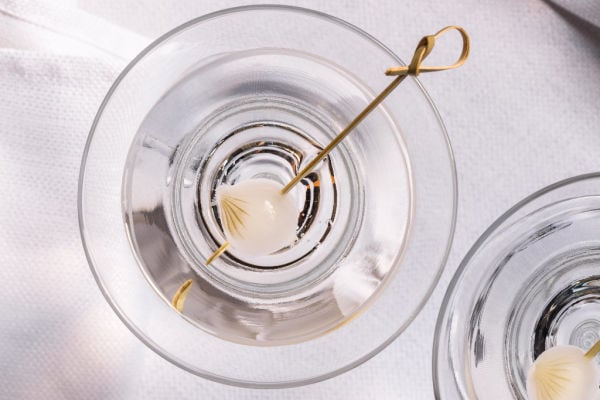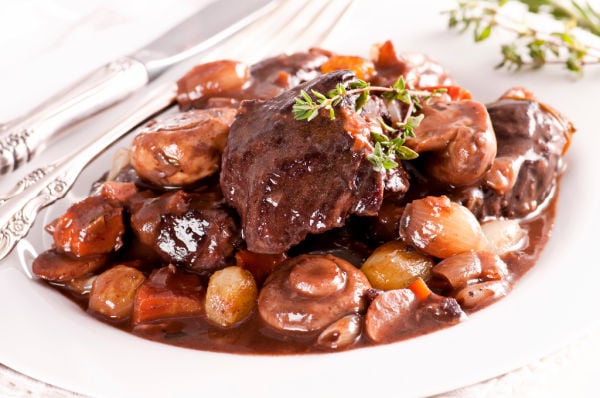Pearl onions are a small variety of onion that are used in many dishes like soups, stews, and sauces. They can also be pickled or added to cocktails. Their mild, sweet flavor makes them a versatile ingredient in the kitchen.
Pearl onions are not always easy to find, and they can often be expensive, depending on where you live. If you want to cook with them or don't have any on hand, here are 8 pearl onion substitutes that will work beautifully!
What are the top 8 substitutes for pearl onions?
To replace fresh pearl onions in cooking we recommend using frozen pearl onions, white onions, or shallots. Cocktail onions or caperberries are handy options if you need a cocktail garnish. Although no alternative will perfectly mimic the size, flavor, or texture of pearl onions, they won’t be out of place in any recipe either.
 1. Frozen pearl onions
1. Frozen pearl onions
Frozen pearl onions are a great substitute for fresh ones. They are usually peeled and can be found in the freezer section of most well-stocked grocery stores.
Frozen pearl onions have less water content than their fresh counterparts, so they'll give you a more concentrated taste. We recommend using them in soup, stews, and sauces in equal quantities.
2. White onions
White onions are a great option when you don't have any pearl onions on hand. They have a sharp zing and plenty of crunch, perfect eaten raw or cooked.
Add them to spicy Mexican cuisine, curries, white sauces, potato salad, or pasta salads. We recommend using ¾ cup white onion to replace ½ cup fresh pearls.
3. Shallots
Fresh shallots have a delicate, sweet flavor with a little sharpness. They are perfect in food that need an aromatic punch like vinaigrette dressings, soups, and stews.
Shallots don't have the same level of sweetness that you'd get from pearl onions. In some recipes, you may want to try adding a little sugar and vinegar to the dish for balance.
Try using ¾ cup of shallots for every cup of pearl onions.
4. Cocktail onions
Cocktail onions have a nice sweetness to them which can be good for balancing out richer meals or adding depth of flavor to food. They are often made from pearl onions that have been pickled in brine with spices like paprika and turmeric.
They have high water content and are milder in taste than pearl onions. Use them in salads, sandwiches, cocktails, antipasto platters, or other dishes where you're looking to add some crunch with less of an onion bite.

Pearl onions add an eye-catching element to cocktails.
Try chopping cocktail onions into small pieces before adding them to your recipe. The flavor is similar to pearl onion, but they will soften a bit more quickly so cook for shorter durations and use less heat. Otherwise, you'll end up with something mushy rather than soft.
5. Caperberries
Do you need to mix up a Martini Standing or a Gibson cocktail that uses pickled pearl onions? Caperberries are a close substitute. They have the same tart, tangy taste as pickled pearl onions but without the added ingredients.
6. Cipollini onions
Cipollini onions are small, flat onions so that can be served whole on top of other food or sliced in half for roasting. They are sweet with a strong oniony flavor, like shallots. Cipollini onions are also versatile and, thanks to their high sugar content, are delicious slow-cooked. They'll also caramelize more easily than many other onion varieties, which is great for adding flavor.
Try adding some chopped cipollini onions when you're making an Italian meal like stuffed shells or lasagna - it'll add texture and flavor.
7. Boiling onions
Although boiling onions are twice the size of pearl onions, they make a great substitute for pearl onions in some recipes. They're perfect when you want to add savory flavor to your dish without adding too much heat or spice.
Boiling onions can be eaten raw offering a pungent kick with a crisp texture. Once cooked, this vegetable is much milder with a delicious tender mouthfeel.
8. Leeks
Leeks are a type of allium and are related to the pearl onion. Their flavor is earthy, sweet, and mildly oniony, making them a potential substitute for pearl onions if you're in a pinch.
Use leeks as an aromatic in a wide range of dishes but keep in mind that they are large and should be sliced before roasting or sauteing them. You can learn how to prepare leeks for cooking here or discover the best substitutes for leek here.
Related reading:
Do you know the difference between onion powder and flakes?
Learn the proper way to slice an onion.

Pearl onions add earthy, sweet flavor to heavy meat dishes.
What does a pearl onion taste like?
Pearl onions have a mild and sweet flavor with a juicy, firm texture. When cooked, they develop a savory-sweet flavor that is less pungent than regular brown onions.
What is the difference between pearl onions and regular onions?
Regular onions are larger than pearl onions and aren't as sweet. They can be used for similar purposes in the kitchen.
7 fast facts about pearl onions
- Pearl onions are also known as creamers, baby, picklers, buttons, or silverskin onions.
- They range in size from ¾ inch to as large as an inch in diameter.
- The pearl onion gets its name from the way it is cultivated by planting them very close together so they form clusters.
- They contain vitamin C, calcium, fiber, flavonoids, and potassium.
- Pearl onions are classified botanically as Allium cepa var. aggregatum and are members of the Amaryllidaceae family.
- The history of the pearl onion is unclear, but it's believed they were first grown in Europe during the 1500s.
- A pearl onion’s skin is thin and papery and is easy to peel, similar to a bulb of garlic.
Conclusion
Pearl onions are a common addition in many dishes and recipes, but what if onions are not available? There are a few substitutes that can be used for pearl onions depending on the meal. If you can't get your hands on fresh pearl onions, then try to find the frozen ones at the grocery store. If you prefer eating fresh, then use white onions or shallots. Cocktail onions or caperberries are perfect for replacing pearl onions in cocktails and antipasto platters.
In some recipes it may be fine to leave the pearl onions out of the recipe and not replace them with anything. For example, a Moroccan soup that’s already bursting with spices, vegetables, and meat won’t miss them.

Celina Windi
I had a major cooking disaster. When I went to make French onion soup recipe, my mom's favorite, I realized after looking at the ingredients list in the cookbook that I didn't have pearl onions. It was too late for me to shop, so I improvised. In a hurry and frustrated by this setback, I grabbed some green onions out of the fridge instead and chopped them up into tiny little pieces (much smaller than they needed to be).
Later on, when she tasted it she said "Did you mess up?" And then she just laughed hard because now we both knew how bad my mistake really was. The problem wasn't that I had used green onions instead. It was that I didn't measure, so there were a lot more of them in the soup than it needed. The flavor still came through and she admitted to me later on that it wasn't the worst dish she'd ever been served.
We've all made mistakes cooking before. You know how it is when you're just getting started and everything seems like a grey area as far as measurements go. It's hard to tell what a pinch of this or that looks like. If I can give a piece of advice when replacing pearl onions in a recipe, it would be to measure everything. I'd also note that if you're also substituting for other ingredients like tomatoes, the recipe will have different proportions of what is being substituted so sometimes it pays to research the ingredient you're using beforehand.
Good luck everyone with your cooking adventures!
Nate Teague
I am sorry to hear that your recipe didn't work out. Thanks for sharing, even though something went wrong during the ingredient calculations! It's discouraging when a culinary adventure doesn't turn out as expected so it's great you could laugh about it. We all have those days where our recipes don't come together like they're supposed to (probably myself more than most). I hope your onion soups have turned out better since then.